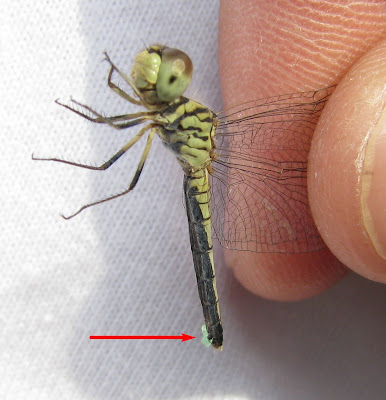An initial plan to go Sungei Buloh was changed to the Tuas marshlands; the enticement was to hard for me to resist, even though I was busy doing some assigments. Thanks Ron for telling me of this change or I would have miss this trip, and LK for organising!
I first read about this place through BESG blog when they announced the reclamation of this site to give way to a racing course for bikers. Subsequently, another more recent entry of LK's trip on the Red-wattled Lapwing.

One of the first photos I took before we reach the wetlands the ground orchid, Spathoglottis plicata. Its name probably says it all, being able to grow from the ground rather than being epiphytic like most orchids.

Today was actually a trip for LK's student to do their dragonfly study. This picture will explain why theres so many dragonflies around.

They live around wetlands because their larvae are aquatic. Above shows a damselfly nymph, a close relative to the dragonflies. The three spikes on the back are their exposed gills, one characteristic to differentiate them from dragonfly nymphs.

A lesson from LK, female dragonflies can release their eggs prematurely when stressed, probably as a strategy that at least they might have a chance of surviving if the mother is caught by a predator. The green ooze are the egg clumps.

LK told us that the Nannophya pygmaea dragonfly is one of the smallest, I think in Singapore. Not sure if its the smallest in the world though. The above is a male. The female has white and yellow strips on the abdomen, can see from my new flickr acc :)
I didnt take many pictures of dragonflies, so hang on for Ron and others for their entry. But think after today and looking through some of my photos, think must agree that they are a great subject for photography :D

What a wonderland this place is for pitcher plants! The slender pitcher Nepenthes gracilis was just all over the entire marshlands. Even this beautiful red color variant above is in such an abundance. These pitchers are the ground pitchers, and easily differentiated from its more pronounced "wings" or fringes running down from the lid, probably as a guide for insects to crawl in to their death.

Heres a picture of the upper pitchers.

Pitcher plants are carnivorous plants (prob everyone knows that) and they secrete nectar to lure their prey into a pit of digestive juices. But some (lazy) animals make use of this lure to capture food for themselves, like the crab spider above, that lives exclusively in pitchers. Not sure of the ID though, does anyone knows?

LK showed us another carnivorous plant, the bladderwort (Utricularia gibba). I had heard of this for sometime, but never had the chance to see it till now. The tiny filaments of this aquatic plant carries many nodes or "bladders" (the black dots seen on the finger) which are able to trap tiny animals for its own nutrition.

And the reclamation works which are already being carrying out. Part of the race track is already accessible as we saw bikers playing round the obstacles in the near vicinity. Its pretty sad that to imagine such a wonderful habitat will be gone soon, together will all the pitcher plants, bladderworts, orchids, dragonflies and another habitat for the birds.
Read more about this amazing place from JL, R and Sm's blogs.
Read more about this amazing place from JL, R and Sm's blogs.

5 comments:
gee its such a waste...is there a way to relocate the pitchers? or the ground orchids? work with NParks or the zoo or a school where a Carnivorous Plant Garden can be set up on the premises? really is a damn waste...
Heya, damn... why do I always miss out. Should have cancelled my other appointment. Then again I was told SBWR initially. That LK ah...
Anyway, the bladderwort is Utricularia gibba (confirmed by my colleague Dr. Tan Swee Hee - Crustacean taxonomist, but also well-versed in carnivorous plants.). Luckily, the bladderworts and pitchers are rather common as indicated by him.
Still... we gonna lose another precious piece of land, esp when I live so close to it. =P
Hey thanks for the ID SJ! Been trying in vain to ID it.
Ya I agree its such a waste... The ground orchid shd be rather common plant too...
Great post you have there! Interesting stuff you saw, and it's very informative too ;) Hehe and thanks for the links to your friends' blogs too! Btw the dragonfly is not the smallest in the world. According yo your friend, the dragonfly expert, "The smallest is probably Agriocnemis naia from Penang with a wingspan of just 1.76 cm". It's a quote from his webbie! ;p
Yupz I saw that, but there are also many webbies that said the pygmy dragonfly is the world's smallest ;p
Thats y I'm not sure still.
Post a Comment